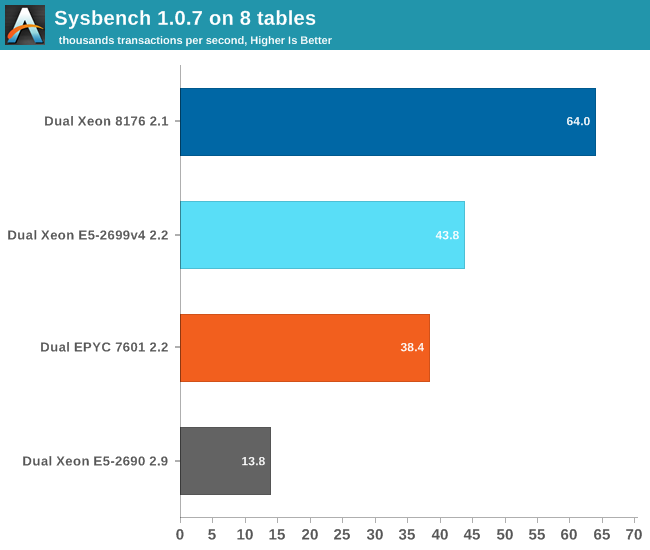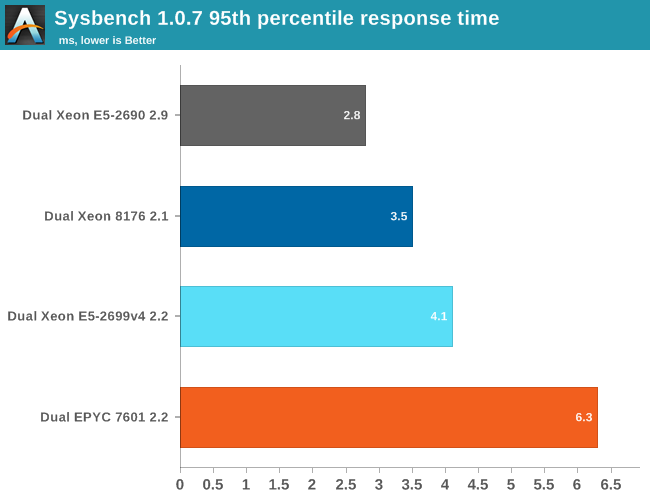Sizing Up Servers: Intel's Skylake-SP Xeon versus AMD's EPYC 7000 - The Server CPU Battle of the Decade?
by Johan De Gelas & Ian Cutress on July 11, 2017 12:15 PM EST- Posted in
- CPUs
- AMD
- Intel
- Xeon
- Enterprise
- Skylake
- Zen
- Naples
- Skylake-SP
- EPYC
Database Performance: MySQL Percona Server 5.7.0
For database benchmarking we still base our testing on Percona server 5.7, an enhanced drop-in replacement for MySQL. But we have updated our SQL benchmarking once again. This time we use Sysbench 1.0.7, which is a lot more efficient than the previous 0.4 and 0.5 versions. As a result, the measured numbers are quite a bit higher, especially on the strongest systems. So you cannot compare this with any similar Sysbench-based benchmarking we have done before.
For our testing we used the read-only OLTP benchmark, which is slightly less realistic, but still much more interesting than most other Sysbench tests. This allows us to measure CPU performance without creating an I/O bottleneck.

As expected, the EPYC 7601 can not deliver high database performance out of the box. A small database that can be mostly cached in the L3-cache is the worst case scenario for EPYC. That said, there are quite a few tuning opportunities on EPYC. According to AMD, if you enable Memory Interleaving, performance should rise a bit (+10-15%?). Unfortunately, a few days before our deadline our connection to the BMC failed, so we could not try it out. In a later article, we will go deeper into specific tuning for both platforms and test additional database systems.
Nevertheless, our point stands: out of the box is the EPYC CPU a rather mediocre transactional database CPU. With good tuning it is possible EPYC may pass the Xeon v4, but the 8176 is by far the champion here. It will be interesting to measure how EPYC compares in the non-transactional databases (Document stores, Key-value...) but transactional databases will remain Intel territory for now.

Typically when high response times were reported, this indicated low single threaded performance. However for EPYC this is not the case. We tested with a database that is quite a bit larger than the 8 MB L3-cache, and the high response time is probably a result of the L3-cache latency.










219 Comments
View All Comments
JKflipflop98 - Wednesday, July 12, 2017 - link
For years I thought you were just really committed to playing the "dumb AMD fanbot" schtick for laughs. It's infinitely more funny now that I know you've actually been *serious* this entire time.ddriver - Wednesday, July 12, 2017 - link
Whatever helps you feel better about yourself ;) I bet it is funny now, that AT have to carefully devise intel biased benches and lie in its reviews in hopes intel at least saves face. BTW I don't have a single amd CPU running ATM.WinterCharm - Thursday, July 13, 2017 - link
Uh, what are you smoking? this is a pretty even piece.boozed - Tuesday, July 11, 2017 - link
You haven't done your job properly unless you've annoyed the fanboys (and perhaps even fangirls) for both sides!JohanAnandtech - Wednesday, July 12, 2017 - link
Wise words. Indeed :-)Ranger1065 - Wednesday, July 12, 2017 - link
If you are referring to ddriver, I agree, wise words indeed.ddriver - Wednesday, July 12, 2017 - link
Well, that assumption rests on the presumption that the point of reviews is to upsed fanboys.I'd say that a "review done right" would include different workload scenarios, there is nothing wrong with having one that will show the benefits of intel's approach to doing server chips, but that should be properly denoted, and should be just one of several database tests and should be accompanied by gigabytes of databases which is what we use in real world scenarios.
CoachAub - Wednesday, July 12, 2017 - link
It was mentioned more than once that this review was rushed to make a deadline and that the suite of benchmarks were not everything they wanted to run and without optimizations or even the usual tweaks an end-user would make to their system. So, keep that in mind as you argue over the tests and different scenarios, etc.ddriver - Thursday, July 13, 2017 - link
It doesn't take a lot of time to populate a larger database so that you can make a benchmark that involves an actual real world usage scenario. It wasn't the "rushing" that prompted the choice of database size...mpbello - Friday, July 14, 2017 - link
If you are rushing, you reduce scope and deliver fewer pieces with high quality instead of insisting on delivering a full set of benchmarks that you are not sure about its quality.The article came to a very strong conclusion: Intel is better for database scenarios. Whatever you do, whether you are rushing or not, you cannot state something like that if the benchmarks supporting your conclusion are not well designed.
So I agree that the design of the DB benchmark was incredibly weak to sustain such an important conclusion that Intel is the best choice for DB applications.